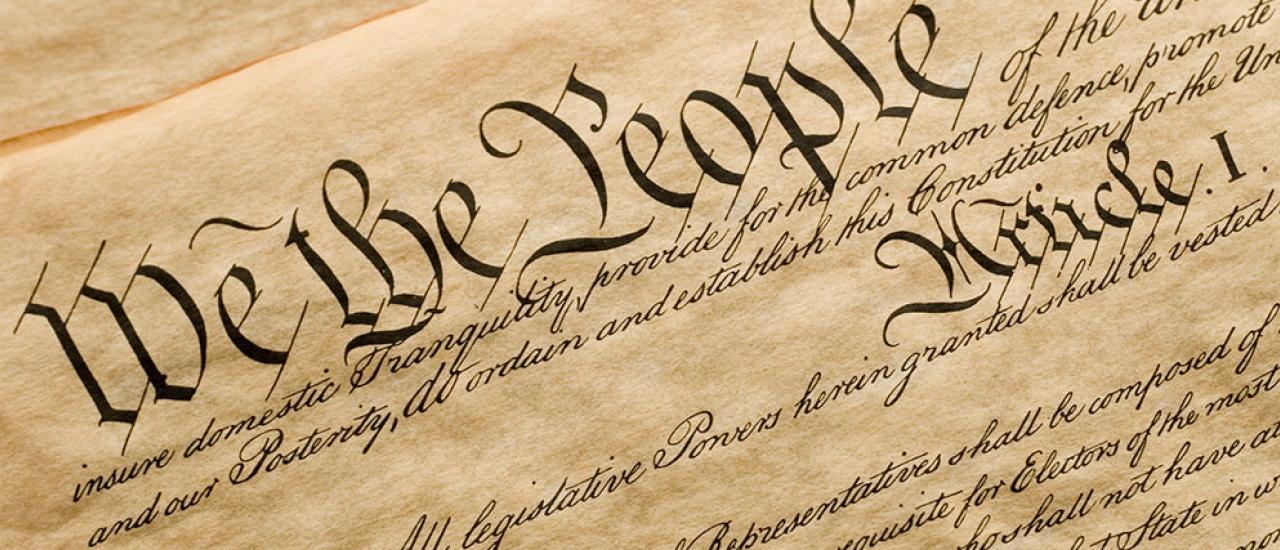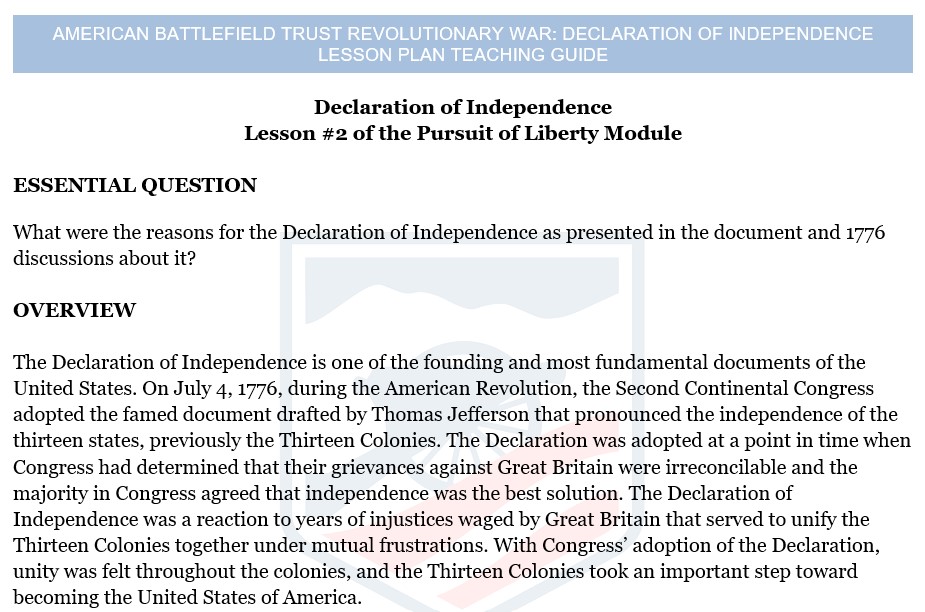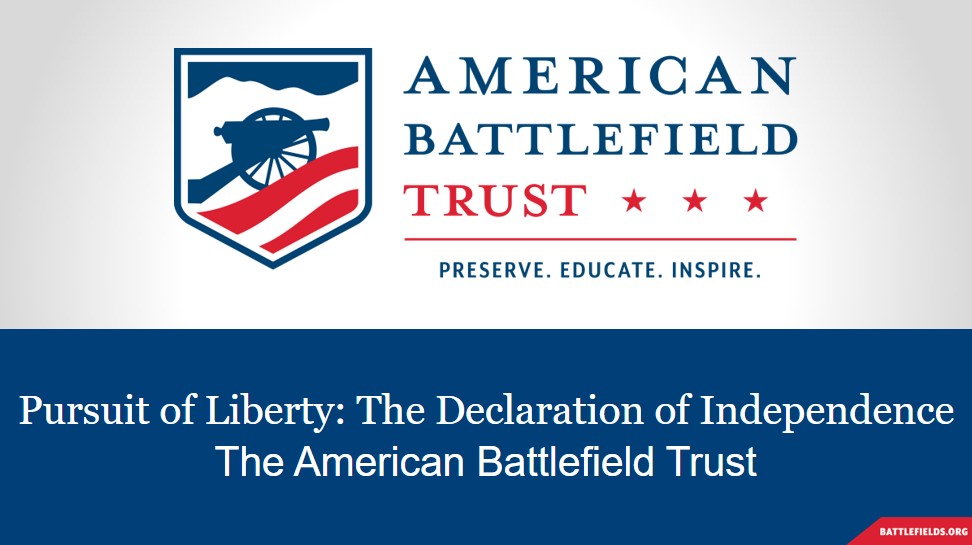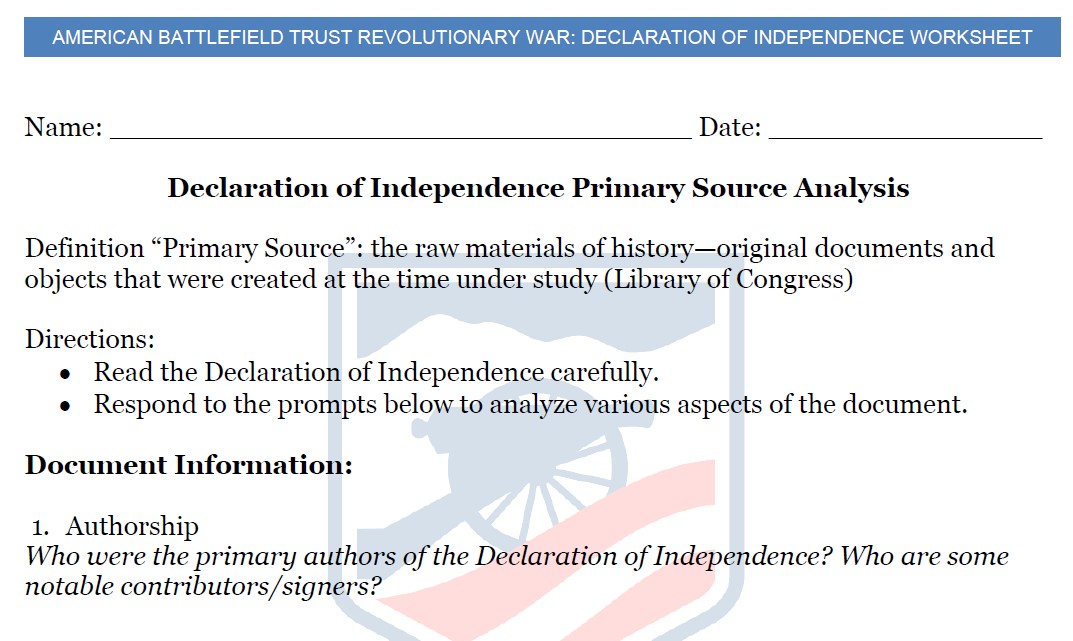
Declaration of Independence Lesson Plan
A lesson plan for use in middle and high school classrooms.
The Declaration of Independence is one of the founding and most fundamental documents of the United States. On July 4, 1776, during the American Revolution, the Second Continental Congress adopted the famed document drafted by Thomas Jefferson that pronounced the independence of the thirteen states, previously the Thirteen Colonies. The Declaration was adopted at a point in time when Congress had determined that their grievances against Great Britain were irreconcilable and the majority in Congress agreed that independence was the best solution. The Declaration of Independence was a reaction to years of injustices waged by Great Britain that served to unify the Thirteen Colonies together under mutual frustrations. With Congress’ adoption of the Declaration, unity was felt throughout the colonies, and the Thirteen Colonies took an important step toward becoming the United States of America.
This Lesson Plan can be used as a prepared resource by following this curriculum plan which aligns to NCSS and Common Core Standards.
This Lesson Plan's assets can also be used on their own as supplemental resources. The display format is prepared for easy access, exploring, and learning.
The Pursuit of Liberty Module
Upon completion of this lesson, the students will be able to:
1. Knowledge
- Describe some of the processes leading to the votes for independence and the writing of the Declaration of Independence.
- Discuss the importance of the Declaration of Independence in the founding of the United States of America.
2. Comprehension/Application/Analysis
- Examine and closely read/analyze the Declaration of Independence.
3. Evaluation
- Evaluate the meaning conveyed by the Declaration of Independence through its structure and phrasing.
Check out the Lesson Plan Teaching Guide for more instructions on using the prepared Lesson Plan.
Lesson Plan Primary Source Activity:
- Use the Lesson’s PowerPoint to explore the context and history; the PowerPoint introduces Essential Questions and lays foundational knowledge about the conflict.
- Watch the video “Declaration of Independence In4”
- As a class, in groups, or individually, have the students read the full text of the Declaration of Independence.
- Distribute the primary source worksheet
- Have the students fill out the primary source worksheet; they can share some of the details that stood out to them with the class.
OPTIONAL HOMEWORK/ASSESSMENT/ADDITIONAL ACTIVITIES:
Option 1: Comparing Declarations
Students can read and compare some of the documents leading to or influencing the Declaration of Independence. Have students note the dates, authors, and similar phrases of the documents. What common ideas exist? What are the major differences of the documents? Students can make a comparison chart, write a short essay, or have a class discussion about their findings.
Option 2: Immediate Reactions to the Declaration of Independence
Students can research the immediate reactions of a signer of the Declaration of Independence and the plan to announce the news to the Continental Army soldiers. After noting the hopes, fears, and reactions in the primary sources, students can write a letter, imagining their own reaction to the news in 1776.
Common Core State Standards- ELA & History/Social Studies
Grades 6-8
- Key Ideas and Details:
- CCSS.ELA-LITERACY.RH.6-8.2
- Determine the central ideas or information of a primary or secondary source; provide an accurate summary of the source distinct from prior knowledge or opinions.
- CCSS.ELA-LITERACY.RH.6-8.2
- Craft and Structure:
- CCSS.ELA-LITERACY.RH.6-8.5
- Describe how a text presents information (e.g., sequentially, comparatively, causally).
- CCSS.ELA-LITERACY.RH.6-8.6
- Identify aspects of a text that reveal an author's point of view or purpose (e.g., loaded language, inclusion or avoidance of particular facts).
- CCSS.ELA-LITERACY.RH.6-8.5
- Integration of Knowledge and Ideas:
- CCSS.ELA-LITERACY.RH.6-8.8
- Distinguish among fact, opinion, and reasoned judgment in a text.
- CCSS.ELA-LITERACY.RH.6-8.8
Grades 9-10
- Key Ideas and Details:
- CCSS.ELA-LITERACY.RH.9-10.1
- Cite specific textual evidence to support analysis of primary and secondary sources, attending to such features as the date and origin of the information.
- CCSS.ELA-LITERACY.RH.9-10.2
- Determine the central ideas or information of a primary or secondary source; provide an accurate summary of how key events or ideas develop over the course of the text.
- CCSS.ELA-LITERACY.RH.9-10.3
- Analyze in detail a series of events described in a text; determine whether earlier events caused later ones or simply preceded them.
- CCSS.ELA-LITERACY.RH.9-10.1
- Craft and Structure:
- CCSS.ELA-LITERACY.RH.9-10.5
- Analyze how a text uses structure to emphasize key points or advance an explanation or analysis.
- CCSS.ELA-LITERACY.RH.9-10.5
- Integration of Knowledge and Ideas:
- CCSS.ELA-LITERACY.RH.9-10.8
- Assess the extent to which the reasoning and evidence in a text support the author's claims.
- CCSS.ELA-LITERACY.RH.9-10.8
Grades 11-12
- Key Ideas and Details:
- CCSS.ELA-LITERACY.RH.11-12.2
- Determine the central ideas or information of a primary or secondary source; provide an accurate summary that makes clear the relationships among the key details and ideas.
- CCSS.ELA-LITERACY.RH.11-12.3
- Evaluate various explanations for actions or events and determine which explanation best accords with textual evidence, acknowledging where the text leaves matters uncertain.
- CCSS.ELA-LITERACY.RH.11-12.2
- Craft and Structure:
- CCSS.ELA-LITERACY.RH.11-12.5
- Analyze in detail how a complex primary source is structured, including how key sentences, paragraphs, and larger portions of the text contribute to the whole.
- CCSS.ELA-LITERACY.RH.11-12.5
- Integration of Knowledge and Ideas:
- CCSS.ELA-LITERACY.RH.11-12.8
- Evaluate an author's premises, claims, and evidence by corroborating or challenging them with other information.
- CCSS.ELA-LITERACY.RH.11-12.8
Social Studies - National Council for the Social Studies
- Theme 2: Time, Continuity, and Change
- Theme 5: Individuals, Groups, and Institutions
- Theme 6: Power, Authority, and Governance
- Theme 9: Global Connections
- Theme 10: Civic Ideals and Practices
This Lesson plan
contains the following:
3 Activities | 23 Resources
This Lesson plan is a part of:
Revolutionary War Curriculum | The Pursuit of Liberty Module



